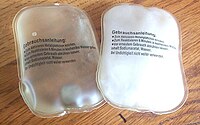
Photo from wikipedia
Abstract Phase change materials (PCMs) based on the principle of latent heat thermal energy storage have been highly concerned by researchers and widely developed in various fields. However, for traditional… Click to show full abstract
Abstract Phase change materials (PCMs) based on the principle of latent heat thermal energy storage have been highly concerned by researchers and widely developed in various fields. However, for traditional PCMs, especially thermosetting solid-solid change materials (SSPCMs) which usually consist of crosslinking structure, the phase change enthalpy was fixed once the materials were constructed. To turn the constant enthalpy into adjustable one, we incorporated the light-sensitive methyl red (MR) groups into polyurethane-based SSPCMs. The MR-containing SSPCMs exhibit amplified enthalpy and increased melting temperature (Tm) after activated by UV light compared with the inactivated ones. UV treatment can promote the crystallization of the soft segment in polyurethane due to the light-induced isomerization of MR groups and visible light causes reverse effect of the activated samples that the enthalpy, Tm and crystallization get back to the original degree, which indicates the nonconstant enthalpy. A separation theory was proposed to explain the increased enthalpy and Tm caused by the cis configuration of MR groups.
Journal Title: Energy and Buildings
Year Published: 2020
Link to full text (if available)
Share on Social Media: Sign Up to like & get
recommendations!